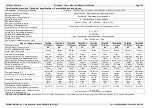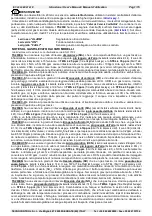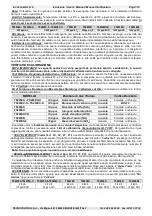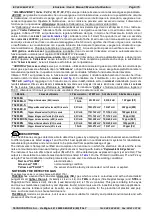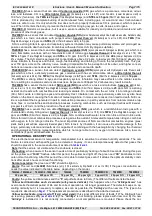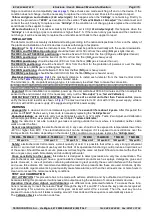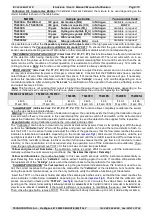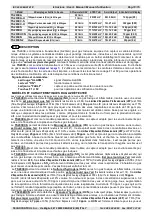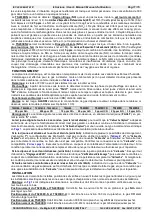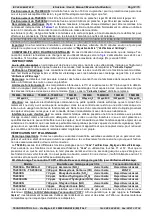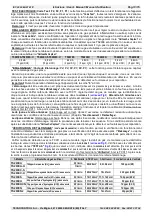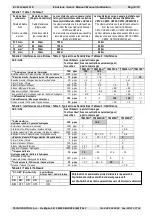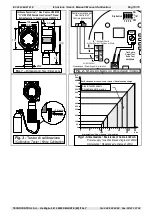
IST-2293.EA01.01/C
Istruzione / User’s Manual / Manuel d’utilisation
Pag.7/15
TECNOCONTROL S.r.l. - Via Miglioli, 47 20090 SEGRATE (MI) ITALY
Tel: 02/26 92 28 90 Fax: 02/21 33 734
TS293EC-S
has a sensor that can detect
Carbon monoxide
(CO
) gas which is a poisonous, colourless, odour-
less, and tasteless. CO is
a little lighter than air
(
its density as to air is 0.97
) and his LEL (
Lower Explosive Limit
) is
10.9%v/v (%volume). His
TWA is 25 ppm
(
Time-Weighted Average
) and
STEL is 35 ppm
(
Short Term Exposure Limit
).
CO is produced by incomplete burning of carbon-based fuels, including gas, oil, wood and coal. Carbon-based
fuels are safe to use. It is only when the fuel does not burn properly that excess CO is produced, which is poison-
ous. When CO enters the body, it prevents the blood from bringing oxygen to cells, tissues, and organs.
TS293EC-H
model is as previous, but it uses a sensor suitable for industry and polluted environments and with
presence of other toxic gases.
TS293ES
has a sensor that can detect
Sulphur dioxide
(SO
2
)
(
also Sulphurous anhydride, Sulphurous oxide, Sulphur oxide
)
gas which is a toxic, colourless, with pungent odour,
heavier than air
(
its density as to air is 2.25
). His
TWA
(
Time-
Weighted Average
) is 2 ppm and
STEL
(
Short Term Exposure Limit
) is 5 ppm.
SO
2
is a strong irritant to eyes and respiratory system. Inhalation may cause pulmonary edema and prolonged ex-
posure can lead to death and when it combines with water forms H
2
S (Hydrogen sulphide).
TS293EH
has a sensor that can detect
Hydrogen sulphide (H
2
S)
(
synonymous with hydrogen sulphide
) gas which is a
toxic, flammable, colorless, with a characteristic odor of rotten eggs,
heavier than air
(
its density as to air is 1.19
). His
TWA
is 5ppm (
Time-Weighted Average
) and
STEL
is 10 ppm (
Short Term Exposure Limit
). His
LEL
(
Lower Explosive Limit
) is
4% volume. The H
2
S smell is perceived at concentrations above 0.2 ppm, to low levels (50÷100 ppm) already pro-
duces irritation to the eyes and throat, cough, fast breathing and training of fluid in the respiratory tract. This gas,
over 150 ppm, acts on the olfactory nerve, making it impossible for the perception of its odour, and higher concen-
trations can cause unconsciousness within a few minutes and can lead to death.
TS293EHCN
has a sensor that can detect
Hydrogen cyanide (HCN)
(synonymous with Hydrocyanic acid, Prussic acid)
gas which is a toxic, extremely poisonous gas, colourless, with has an almond-like odour,
a little lighter than air
(
its density as to air is 0.94
). His
TWA
(
Time-Weighted Average
) is
4.7
ppm and
STEL
(
Short Term Exposure Limit
) is
10 ppm
.
The
HCN
is a strong irritant to eyes and respiratory system. Inhalation may cause effects on the cellular respira-
tion, resulting in convulsions and unconsciousness. Exposure to 300ppm for 2 minutes may result in death.
TS293EN
has a sensor that can detect
Nitric oxide (NO)
gas which is a toxic and colourless,
heavy as air
(
its den-
sity as to air is 1.04
). His
TWA
(
Time-Weighted Average
) and
STEL
(
Short Term Exposure Limit
) are
25
ppm. NO is a strong
oxidant and reacts with combustible and reducing materials. On contact with the air turns it into nitrogen dioxide
(
NO
2
). Nitric oxide is irritating to eyes and respiratory tract. Inhalation can cause pulmonary edema, may also have
effects on the blood, causing the formation of metaemoglobina. In more severe cases it can lead to death. Nitric ox-
ide is a pollutant that is generated in part in combustion processes, in part by emissions from natural volcanic erup-
tions, fires or civil activities and industrial processes involving combustion, such as transport (
vehicles with diesel en-
gine, gasoline, LPG, etc.
) and the production of heat and electricity.
TS293EN2
has a sensor that can detect
Nitrogen dioxide (NO
2
)
gas which is a reddish-brown toxic gas with a
characteristic sharp, biting odour,
heavier than air
(
its density has to air is 1.58
). His
TWA
(
Time-Weighted Average
) is 3
ppm and
STEL
(
Short Term Exposure Limit
) is
5 ppm
. NO
2
combined with water turns into nitric acid and nitric oxide.
NO
2
is formed in most combustion processes using air as the oxidant. At elevated temperatures nitrogen combines
with oxygen to form nitrogen dioxide. The most important sources of NO
2
are internal combustion engines (
power
plants, heating and vehicles, especially diesel engines
). NO
2
is toxic by inhalation, it can cause irreversible damage to the
lungs, pulmonary edema and death as it is capable of combining with the haemoglobin by changing the chemical
and physiological, forming metaemoglobina which is no longer able to carry oxygen to the tissues. Also, low con-
centrations (4 ppm) will anesthetize the nose.
OPERATIONAL DESCRIPTION
The electrochemical sensor is temperature compensated, but is sensitive to extreme humidity variations. The cali-
bration is carried out with specific gas to be detected. Anyway, it can contemporaneously detect other gases that
should be present in the same environment as listed in
tables 2 and 3
.
Note
that the Led are not visible when the enclosure is closed.
Preheating
: when powered, the sensor needs a time of preliminary heating of about 60 seconds. During this peri-
od the yellow Led “
FAULT
” flashes. After this period, the yellow Led light off, the green Led “
ON
” illuminates to indi-
cate normal functioning. After this period the unit is able to detect gas even if it attains the optimum stability condi-
tions after about 4 hours continual functioning.
Normal operation
: the green Led “ON” should be light on.
Alarm
:
The red Led (
ALARM
) illuminates (
only if it be activate by Dip-Switch no.1 set to ON
) if the gas concentration ex-
ceeds the value indicated in the table below, depending on the model.
TS293EA - TS293EA-H
TS293EC-S - TS293EC-H
TS293ES
TS293EH
TS293EHCN
TS293EN
TS293EN2
50 ppm NH
3
200 ppm CO
10 ppm SO
2
20 ppm H
2
S
5 ppm HCN
25 ppm NO
30 ppm NO
2
Faults
:
the yellow Led illuminates and the "
S
" output falls down to 0mA. (The different faults are listed below).
Yellow Led illuminates each 4 seconds (
with green Led activate
):
this happens when the “
Cartridge Sensor
” has
overcome its theoretical period of life and its correct operation is not longer guaranteed. The detector keeps on op-
erating normally but it is necessary to replace, as soon as possible, the “
Cartridge
” with a new one. The type to be
required is described on
Page 1
. The replacement procedure is described in the attached manual.
Yellow Led activate, green Led off (
0 mA output signal
):
this signal different kind of faults.
1)
The Dip-Switch set
up is wrong, please verify (
see Table 4
).
2)
The “
Cartridge
” is not working, please replace with new one.
3)
If a new
“
Cartridge
” is installed or it is not correctly connected or a not compatible one is mounted. Please check the car-


